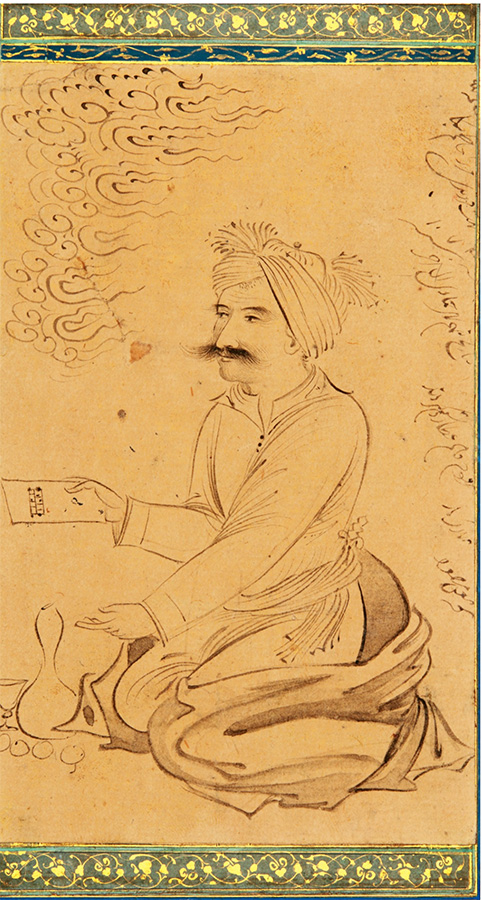Moʿin Moṣavver | Individual Drawings and Paintings
Drawing 1663.2
Man with a Moustache,
Holding a Sheet of Paper
Location: Current whereabouts unknown
Drawing: ink on paper mounted on an album page. Drawing 13 x 8 cm. Leaf 15.2 x 9.9 cm.
Signature: Signed and dated 1073/1663 (year uncertain; last digit of year partially trimmed in mounting and could possibly be 1074/1664 ).
Inscription
On right side,
reads:
hedmati farzandi ʿaziz qāsem ......bejehat-e betāriḵ-e nahom-e šahr-e jomādi al-aḥer sana 1073 [or 1074]. marhum-e qāhem attār dālgām kārdan. mobārak bād. ..... moʿin-e moṣavver.
Translation: "....my dear child Qāsem .... recorded for history the ninth of the month of Jomadi II in the year 1073 / 19 January 1663 [or if 1074 / 8 January 1664]. This drawing was draped upon me [inspired] by the late Attār; May he be blessed. ..... Moʿin Moṣavver."
Description:
A man of thirty plus years, sporting a wide moustache, is seated on the ground facing the left. He wears a turban and a long robe that folds under him, and is bound at the waist with a sash. In his right hand he holds a sheet of paper that he is passing to someone beyond the picture. The paper has a few lines written on it, therby suggesting that the subject may be a merchant, or perhaps a poet. A flask, a cup, and some fruit are placed on the ground before him; stylized clouds are drawn in the upper left.
Bibliography:
Martin, II, pl.164 top right.
Stchoukine, SA, p.66 (not ill.).
Sothebys (London), 20 April 2016, Lot 58
Commentary:
The drawing not only has a signed and dated inscription in the handwriting of Moʿin, but portrays what has become a virtual hallmark of the Moʿin style -- the wide moustached macho man. Similar personage are represented in 1638.4, 1670.1, and 1676.4, but one need only comb through the many manuscript pages illustrated by Moʿin to find numerous examples of such types. Two names are cited in the inscription. The first is Qāsem, who Moʿin refers to as his dear farzandi, an appelation in Persian of wide latitude. It can refer to a son, or someone who is like a son, or just a close friend. In this case Qāsem could be the subject of this portrait, or another person to whom the drawing was given. We don't know. The second name mentioned in the inscription is Attār, presumably the prominent Sufi poet of years earlier. How Attār may have influenced this drawing is not quite clear; perhaps it is a vague reference to the subject being a poet or Sufi. Again we do not know.
Photo courtesy of Sothebys
Robert Eng
Last Updated: 12 July 2020 | Originally published: 12 July 2020
